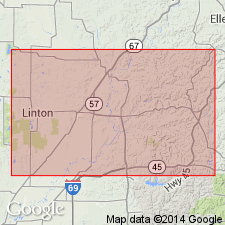
- Usage in publication:
-
- Beech Creek limestone
- Modifications:
-
- Original reference
- Dominant lithology:
-
- Limestone
- AAPG geologic province:
-
- Illinois basin
Summary:
Pg. 7-20. Beech Creek limestone in Chester group. Two or more massive to thin-bedded ledges with total thickness of 8 to 24 feet. Is gray, compact to suboolitic, and often crystalline limestone, frequently completely oolitic. Upper part contains interbedded sand and clay. Fossilferous (PRODUCTUS brachiopods, crinoid stems). Is "middle" or "second" limestone of Chester Series of Indiana. Underlies Cypress sandstone and overlies Elwren sandstone and shale. Exposed from Owen County southward to Ohio River; also exposed in central northern Kentucky. Age is Late Mississippian.
Named from exposures along Beech Creek, Green Co., southwestern IN.
[GNC remark (ca. 1938, US geologic names lexicon, USGS Bull. 896, p. 144): Later reports give thicknesses up to 75 feet.]
Source: US geologic names lexicon (USGS Bull. 896, p. 144); supplemental information from GNU records (USGS DDS-6; Reston GNULEX).
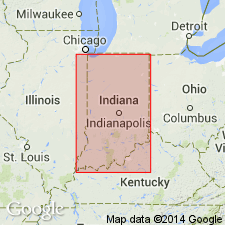
- Usage in publication:
-
- Beech Creek limestone
- Modifications:
-
- Revised
- AAPG geologic province:
-
- Illinois basin
Summary:
[See entry under Beech Creek Shale.]
Source: US geologic names lexicon (USGS Bull. 896, p. 144).
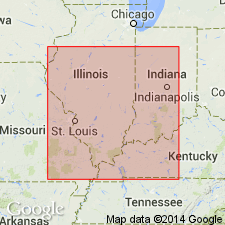
- Usage in publication:
-
- Beech Creek limestone member
- Modifications:
-
- Revised
- AAPG geologic province:
-
- Illinois basin
Summary:
Pg. 828; J.M Weller and others, 1948, GSA Bull., v. 59, no. 2, chart 5 (column 76). Beech Creek limestone considered member of Paint Creek formation in Indiana. Age is Late Mississippian (Chester).
Source: US geologic names lexicon (USGS Bull. 1200, p. 270-271).
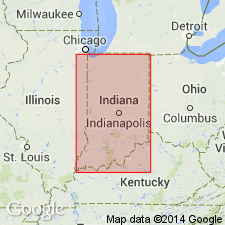
- Usage in publication:
-
- Beech Creek limestone
- Modifications:
-
- Principal reference
- AAPG geologic province:
-
- Illinois basin
Summary:
Pg. 7, 14-17, 73. Beech Creek limestone. Paint Creek of standard Chester column has triple expression in southern Indiana (ascending): Reelsville limestone, Elwren sandstone, and Beech Creek limestone. Each of these is a distinct stratigraphic unit in parity with other formations of the Chester and deserves a name in its own right. At designated type section, Beech Creek limestone is 24.5 feet thick. Persistent through area of outcrop except where it is truncated and overlapped by Pennsylvanian Mansfield. Age is Late Mississippian (Chester).
Type section: at Ray's Cave, in NE/4 NW/4 sec. 13, T. 7 N., R. 4 W., 0.25 mi north of State Road 54 at Ridgeport, and 3.5 mi southwest of Solsberry, Greene Co., southwestern IN.
Source: US geologic names lexicon (USGS Bull. 1200, p. 270-271).
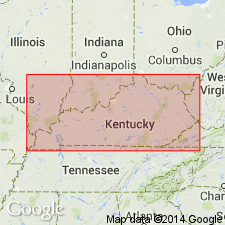
- Usage in publication:
-
- Beech Creek limestone member
- Modifications:
-
- Revised
- AAPG geologic province:
-
- Illinois basin
Summary:
Pg. 18, 20. Beech Creek limestone member, lower member of Golconda formation. Underlies Fraileys shale member (middle member of Golconda) (new). Age is Late Mississippian (Chester).
Source: US geologic names lexicon (USGS Bull. 1200, p. 270-271).
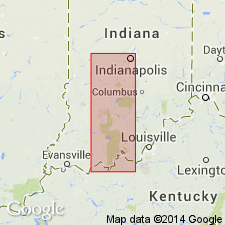
- Usage in publication:
-
- Beech Creek limestone
- Modifications:
-
- Revised
- AAPG geologic province:
-
- Illinois basin
Summary:
Pg. 25, 72-78, pl. 1. Beech Creek limestone. Thickness 8 to 33 feet in Indiana. Gray fine- to coarse-grained crystalline limestone weathering to rough cubical blocks; large crinoid stems common. Underlies Cypress sandstone; locally transition contact separates the two. Overlies Elwren sandstone. Age is Late Mississippian (Chester).
Source: US geologic names lexicon (USGS Bull. 1200, p. 270-271).
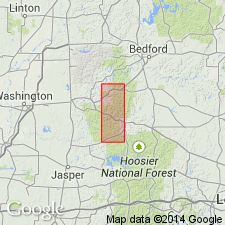
- Usage in publication:
-
- Beech Creek limestone
- Modifications:
-
- Revised
- AAPG geologic province:
-
- Illinois basin
Summary:
Pg. 36 (table 5), 41-42, pl. 1. Beech Creek limestone, lowermost formation of Stephensport group (redefined). Thickness 12 to 18 feet. Underlies Big Clifty formation; overlies Elwren formation of West Baden group. Age is Late Mississippian (Chester).
Source: US geologic names lexicon (USGS Bull. 1200, p. 270-271).
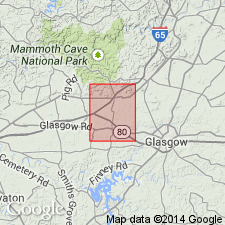
- Usage in publication:
-
- Beech Creek Member*
- Modifications:
-
- Overview
- AAPG geologic province:
-
- Illinois basin
Summary:
Beech Creek Limestone Member of Golconda Formation adopted by the USGS for use in Kentucky.
Source: GNU records (USGS DDS-6; Reston GNULEX).
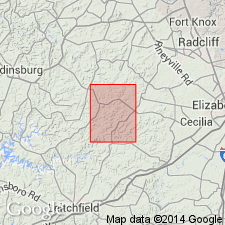
- Usage in publication:
-
- Beech Creek Limestone Member*
- Modifications:
-
- Overview
- AAPG geologic province:
-
- Illinois basin
Summary:
Beech Limestone Member, basal member of Golconda Formation. Medium-gray to light-olive-gray, mostly very fine-grained, even thin-bedded limestone. Upper 1 to 3 feet pale-brown, coarse-grained, fossiliferous (INFLATIA INFLATIA (McChesney) productid and spiriferid brachiopods, crinoid debris, horn corals), locally coquinoid. Basal 2 feet fine-grained, dense, yellowish-orange weathering limestone, locally pyritic. Total thickness 0 to 15 feet. Overlies equivalent of Elwren Sandstone of Malott (1919), contact is conformable, sharp and planar. Disconformably underlies Big Clifty Sandstone Member of Golconda Formation. Age is Late Mississippian (Chesterian).
Source: Modified from GNU records (USGS DDS-6; Reston GNULEX).
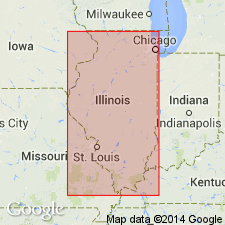
- Usage in publication:
-
- Beech Creek Limestone
- Modifications:
-
- Overview
- AAPG geologic province:
-
- Illinois basin
Summary:
Pg. 155-156. Beech Creek Limestone, basal formation of Golconda Group, and locally in western Illinois, is basal formation of Okaw Group. Commonly called "Barlow lime." Lower part, argillaceous, dark-brownish-gray, dense to lithographic limestone, usually with scattered, black, rounded grains and a few fossils. Upper part, light-brownish-gray, fine- to coarse-grained, fossiliferous, and similar to limestone higher in Golconda Group. Some beds carry pelecypods EUPHEMIA RANDOLPHENSIS and brachiopods MARTINIA CONTRACTA. Thickness 35 to 40 feet in northern areas; thins to the south (opposite of other Chester formations). Locally in Saline and Hamilton Counties, southern Illinois, is a calcareous sandstone bed. Overlies Cypress Sandstone of West Baden Group; underlies Frailey Shale of Golconda (Okaw). Age is Late Mississippian (Chesterian); top of Beech Creek corresponds with base of provincial Hombergian Stage (middle Chesterian) of Swann (1963, Illinois Geol. Survey Rpt. Inv., no. 216).
Source: Publication.
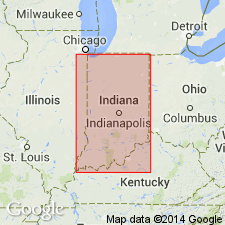
- Usage in publication:
-
- Beech Creek Limestone
- Modifications:
-
- Overview
- AAPG geologic province:
-
- Illinois basin
Summary:
Beech Creek Limestone of Stephensport Group.
Indiana Geological Survey usage is Beech Creek Limestone of Stephensport Group. Described as typically a gray skeletal to biomicritic limestone 8 to 33 ft thick. Typical fossils include large crinoid columnals as much as 25 mm in diameter and a variety of large brachiopods. Crops out from Owen Co. (west-central part of State) southward to the Ohio River. Most widely recognized marker in Chester Series in subsurface to west. Sometimes called Barlow lime. Conformably underlain by Elwren Formation; conformably overlain by Big Clifty Formation or disconformably by Mansfield Formation (Morrowan).
Source: GNU records (USGS DDS-6; Reston GNULEX).
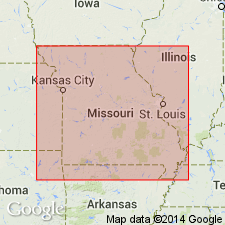
- Usage in publication:
-
- Beech Creek Limestone Member
- Modifications:
-
- Overview
- AAPG geologic province:
-
- Illinois basin
Summary:
Beech Creek Limestone Member, basal member of Golconda Formation. Dark-gray to brown limestone; carries abundant foraminifers, small gastropods, and pelecypods. Thickness 5 to 20 feet. Age is Late Mississippian (Chesterian).
Source: Modified from GNU records (USGS DDS-6; Reston GNULEX).
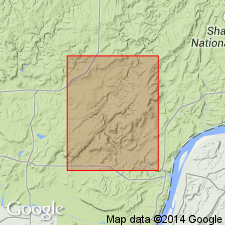
- Usage in publication:
-
- Beech Creek Limestone Member
- Modifications:
-
- Revised
- AAPG geologic province:
-
- Illinois basin
Summary:
Pg. 7; also Weibel and others, 1991, Illinois Geol. Survey Geol. Quad. Ser. IGQ-8. Beech Creek Limestone Member, lower member of Golconda Formation of Pope Group. Golconda, reduced to formation rank in this report, includes (ascending) Beech Creek Limestone Member, Fraileys Shale Member, and Haney Limestone Member (all reduced in rank). Beech Creek and Fraileys not exposed in Waltersburg quadrangle, Pope County, southeastern Illinois; only the Haney is exposed. Age is Late Mississippian (Chesterian).
Source: Publication.
For more information, please contact Nancy Stamm, Geologic Names Committee Secretary.
Asterisk (*) indicates published by U.S. Geological Survey authors.
"No current usage" (†) implies that a name has been abandoned or has fallen into disuse. Former usage and, if known, replacement name given in parentheses ( ).
Slash (/) indicates name conflicts with nomenclatural guidelines (CSN, 1933; ACSN, 1961, 1970; NACSN, 1983, 2005, 2021). May be explained within brackets ([ ]).

